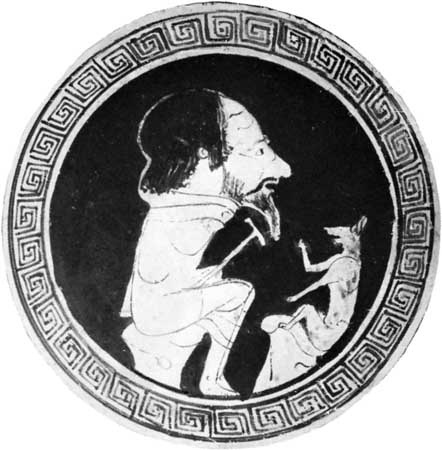fable
literature
narrative form, usually featuring animals that behave and speak as human beings, told in order to highlight human follies and weaknesses. A moral—or lesson for behaviour—is woven into the story and often explicitly formulated at the end. (See also beast fable.)
 The Western tradition of fable effectively begins with Aesop, a likely legendary figure to whom is attributed a collection of ancient Greek fables. Modern editions contain up to 200 fables, but there is no way of tracing their actual origins; the earliest known collection linked to Aesop dates to the 4th century BCE. Among the Classical authors who developed the Aesopian model were the Roman poet Horace, the Greek biographer Plutarch, and the Greek satirist Lucian.
The Western tradition of fable effectively begins with Aesop, a likely legendary figure to whom is attributed a collection of ancient Greek fables. Modern editions contain up to 200 fables, but there is no way of tracing their actual origins; the earliest known collection linked to Aesop dates to the 4th century BCE. Among the Classical authors who developed the Aesopian model were the Roman poet Horace, the Greek biographer Plutarch, and the Greek satirist Lucian.Fable flourished in the Middle Ages, as did all forms of allegory, and a notable collection of fables was made in the late 12th century by Marie De France. The medieval fable gave rise to an expanded form known as the beast epic—a lengthy, episodic animal story replete with hero, villain, victim, and an endless stream of heroic endeavour that parodied epic grandeur. The most famous of these is a 12th-century group of related tales called Roman de Renart; its hero is Reynard The Fox (German: Reinhart Fuchs), a symbol of cunning. Two English poets reworked elements of the beast epic into long poems: in Edmund Spenser (Spenser, Edmund)'s Prosopopoia; or, Mother Hubberd's Tale (1591) a fox and an ape discover that life is no better at court than in the provinces, and in The Hind and the Panther (1687) John Dryden (Dryden, John) revived the beast epic as an allegorical framework for serious theological debate.
The fable has traditionally been of modest length, however, and the form reached its zenith in 17th-century France in the work of Jean de La Fontaine (La Fontaine, Jean de), whose theme was the folly of human vanity. His first collection of Fables in 1668 followed the Aesopian pattern, but his later ones, accumulated during the next 25 years, satirized the court and its bureaucrats, the church, the rising bourgeoisie—indeed, the whole human scene. His influence was felt throughout Europe, and in the Romantic period his outstanding successor was the Russian Ivan Andreyevich Krylov (Krylov, Ivan Andreyevich).
The fable found a new audience during the 19th century with the rise of children's literature. Among the celebrated authors who employed the form were Lewis Carroll (Carroll, Lewis), Kenneth Grahame (Grahame, Kenneth), Rudyard Kipling (Kipling, Rudyard), Hilaire Belloc (Belloc, Hilaire), Joel Chandler Harris (Harris, Joel Chandler), and Beatrix Potter (Potter, Beatrix). Though not writing primarily for children, Hans Christian Andersen (Andersen, Hans Christian), Oscar Wilde (Wilde, Oscar), Antoine de Saint-Exupéry (Saint-Exupéry, Antoine de), J.R.R. Tolkien (Tolkien, J.R.R.), and James Thurber (Thurber, James) also used the form. A sobering modern use of fable is to be found in George Orwell (Orwell, George)'s Animal Farm (1945), a scathing allegorical portrait of Stalinist Russia.
The oral tradition of fable in India may date as far back as the 5th century BCE. The Panchatantra, a Sanskrit compilation of beast fables, has survived only in an 8th-century Arabic translation known as the Kalīlah wa Dimnah, named for two jackal-counselors (Kalīlah and Dimnah) to a lion king. It was translated into many languages including Hebrew, from which in the 13th century John of Capua made a Latin version. Between the 4th and 6th centuries, Chinese Buddhists adapted fables from Buddhist India as a way to further the understanding of religious doctrines. Their compilation is known as Bore jing.
In Japan (Japanese literature) the 8th-century histories Kojiki (“Records of Ancient Matters”) and Nihon shoki (“Chronicles of Japan”) are studded with fables, many on the theme of small but intelligent animals getting the better of large and stupid ones. The form reached its height in the Kamakura period (1192–1333). In the 16th century, Jesuit missionaries introduced Aesop's fables into Japan, and their influence persisted into modern times.
- Triple Entente
- triple jump
- tripletail
- triplite
- tripod
- Tripoli
- tripoli
- Tripolitania
- Tripolitan War
- Trippe, Juan T.
- Tripura
- Tripura Hills
- Tripura Plains
- Triratna
- trireme
- Trisha Brown
- Trishala
- trisomy 13
- trisomy 18
- Trissino, Gian Giorgio
- Tris Speaker
- Tristan and Isolde
- Tristan Bernard
- Tristan Corbière
- Tristan da Cunha